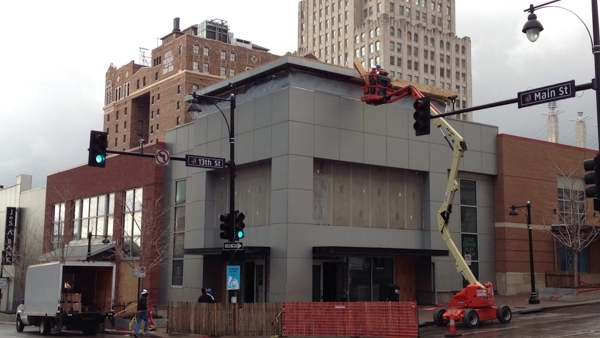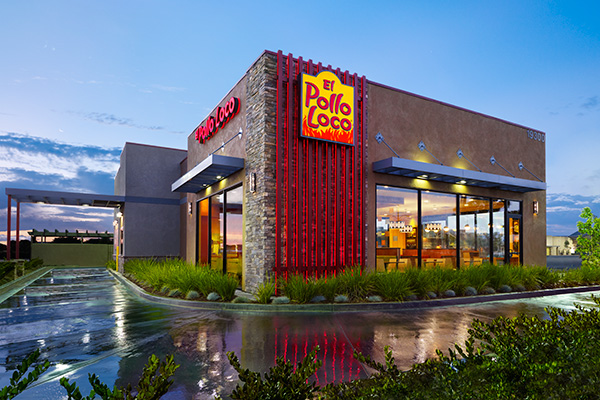Since the COVID-19 pandemic abated, Shucking Good Hospitality has opened two upscale restaurants in the Denver suburbs, Blue Oyster Bar and Oliver’s Italian. Supplied directly from a shellfish farm off Long Island, N.Y., the two establishments bring a distinctive bill of fare to the Denver area, where fresh seafood is hard to come by.
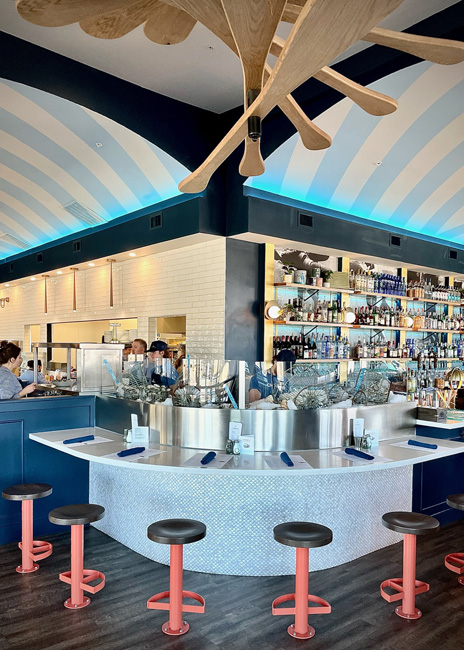 Shucking Good Hospitality opted to open two unique concepts in suburban Denver. Blue Island Oyster Bar offers an unusually elevated suburban experience. Image courtesy FAM DesignPrior to the pandemic, downtown Denver would have been a prime area to site such higher-end, specialized restaurants. Owners would bank on the throngs of white-collar executives from urban offices looking to woo clients or meet with colleagues after work as a key customer base. Urban hubs are still viable locations for restaurants, of course, but the work-from-home trend seems to have changed the makeup of downtowns for now. Many lack the vitality of pre-pandemic times, and there is a smaller pool of restaurant patrons based there. As a result, some restaurateurs are bringing their businesses to where customers are spending more of their time — residential hubs beyond city centers.
Shucking Good Hospitality opted to open two unique concepts in suburban Denver. Blue Island Oyster Bar offers an unusually elevated suburban experience. Image courtesy FAM DesignPrior to the pandemic, downtown Denver would have been a prime area to site such higher-end, specialized restaurants. Owners would bank on the throngs of white-collar executives from urban offices looking to woo clients or meet with colleagues after work as a key customer base. Urban hubs are still viable locations for restaurants, of course, but the work-from-home trend seems to have changed the makeup of downtowns for now. Many lack the vitality of pre-pandemic times, and there is a smaller pool of restaurant patrons based there. As a result, some restaurateurs are bringing their businesses to where customers are spending more of their time — residential hubs beyond city centers.
“Shucking Good Hospitality is offering a higher level of refinement in food and cocktail programs than people are used to in the suburbs,” says Megan Freckelton, interior designer, co-founder, FAM Design. Bringing a new concept to where people are spending more of their time instead of aiming to draw them to a central hub where parking has always been tight makes good business sense.
Suburbs offer a couple of other advantages, points out Frank Mataipule, architect, co-founder, FAM Design. “Even before COVID, there was some hesitation to open in downtown locations,” he says. High rents discouraged some owners from taking a chance on city centers. Suburban sites, in many cases, continue to provide better deals on rent. What’s more, it can be easier to staff suburban locations that are closer to where bartenders, waiters, and back-of-the-house staff live due to housing costs. And, ample free parking, common in the suburbs, makes it easier for staff to commute.
The suburbs have always been attractive for quick-service expansion, and the post-pandemic work-from-home environment reinforces suburban site advantages. Suburban sites are more likely to have the space and suitable site configuration for drive-thrus, a key consideration for many brands that saw to-go business soar during the pandemic. To-go business, for many brands, continues to outpace the level of pre-pandemic takeout sales.
Cici’s Pizza, a brand with more than 270 sites, is almost entirely located in suburban areas. Most of its outlets are sized to about 4,000 square feet and require 50 to 55 parking spaces, says Debbie McGee, director of franchise sales and development, at Dallas-based CiCi’s. “Drive-thrus have been especially important after the pandemic,” she says. “Most new sites are ideally end caps, so we can add a drive-thru,” McGee says. End cap units are more likely to be found in the suburbs than in the urban core.
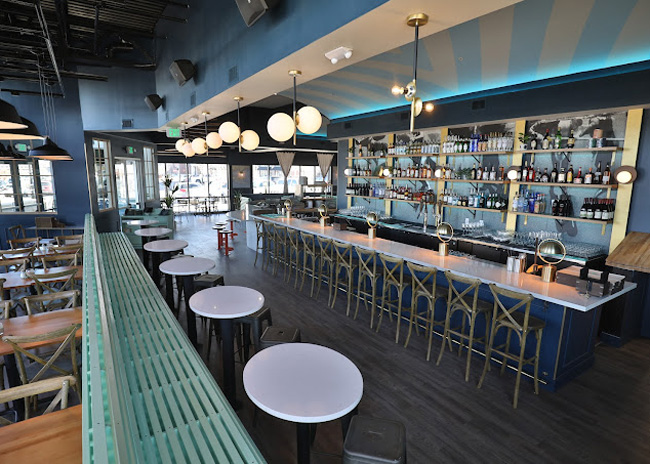 Blue Island Oyster Bar, designed by FAM Design, brings an urban vibe to the Denver suburbs. Image courtesy FAM Design
Blue Island Oyster Bar, designed by FAM Design, brings an urban vibe to the Denver suburbs. Image courtesy FAM Design
Moving on Out
Few city center sites are suitable for a brand that requires a large footprint like CiCi’s. But another quick-service brand with smaller stores, MOOYAH, has been expanding in some urban settings as well as in suburban areas. The burger and shake chain has developed inline spaces in downtown areas in recent years. “Before the pandemic we were focused on end cap spaces of about 2,200 square feet,” says Landon Lane, senior director of construction and design, MOOYAH. “Now we’re doing some inline sites of around 1,200 square feet. This is opening a lot more opportunities. There are more sites available to us.”
Until recently, MOOYAH has stayed away from drive-thrus, but will be opening its first site with a drive-up window later this year in Frisco, Texas. If drive-thrus become more central to the brand’s business model, they’ll have to be in stores located in end-cap or standalone spaces, as inline sites can’t support them. The most desirable end-cap locations will be found mostly in the suburbs.
The most optimal suburban sites are in population nexuses that have a particular set of attributes. MOOYAH looks for areas with a minimum population of 100,000 within a 5-mile radius, Lane says. Retail developments with strong supermarket tenants are ideal locations, he says.
Cici’s prizes sites that are close to schools, sports fields and recreational facilities. These amenities tend to draw families and groups who patronize Cici’s outlets after games and practices. Hospitals, too, provide a stream of customers, particularly for lunch, McGee says. Some of the chain’s locations offer afternoon happy hour buffets to draw seniors visiting nearby medical centers for appointments.
Pedestrian traffic can be a huge plus for a restaurant site. Jason Hlewicki, director of special projects, Swinerton Carolinas, notes that a new greenway in Charlotte, N.C. that adjoins a light rail line has promoted foot traffic and enviable visibility for restaurant clients. For guests, the site, with numerous walkers strolling by, enhances the experience with people-watching opportunities.
“Outdoor space in general is high on the list of criteria for choosing a site,” Hlewicki says. Some clients add 1,000 to 4,000 square feet of outdoor dining space. “Open-air communal space is quite popular,” he says. Many eateries go beyond placing picnic tables on a patio, instead providing full table service and sophisticated menu options for outdoor dining. “You can get a flank steak or paella or keep it simple and have fish tacos and a beer,” Hlewicki says.
Some Swinerton clients add outdoor amenities such as coverings, infrared heaters, and cooling misters for the comfort of guests. “Another trend is pet-friendly spaces — fenced in areas for dogs,” Hlewicki says. A few establishments have installed small playground areas for children.
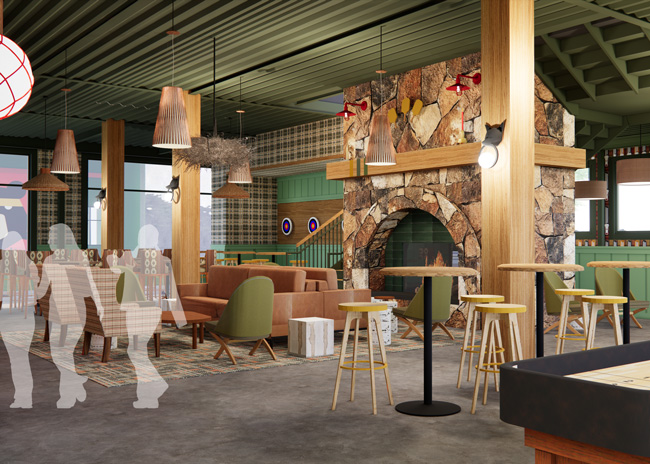 A new concept designedy FAM Design, Camp Pickle combines the red-hot sport sport of pickleball with a sophisticated cocktail and dining program. Image courtesy FAM Design
A new concept designedy FAM Design, Camp Pickle combines the red-hot sport sport of pickleball with a sophisticated cocktail and dining program. Image courtesy FAM Design
Don’t Get Mixed Up
Mixed-use developments are increasingly attractive locations in both urban and suburban areas. These settings typically offer retail and food and beverage on the first floor with residential units above. “High density residential is an angle to success,” Mataipule says.
Increasingly, mixed-use developers look to food and beverage as a key component to add to residential space. “The attraction of amenities to help lease units in multifamily is key,” Hlewicki says. For that reason, there has been a move from garden-style to podium-style construction, with the latter able to accommodate ground-floor restaurant and retail businesses.
Anywhere food and beverage businesses are close to residential space, the restaurant must consider the impact of outdoor space on residents, Freckelton says. The restaurant or bar might have to restrict late night hours and lower the volume on piped-in music or events like karaoke. Being mindful of hood exhausts, which can be loud when cranked up to full capacity, is another important issue.
In a large retail environment such as lifestyle centers that include many types of retailers, food and beverage, entertainment, and residential units, restaurants try to find ways to get noticed. Adding outdoor patios helps to distinguish a space in such developments. Umbrellas and canopies help identify an establishment as a restaurant from a fair distance, Freckleton says. “Sometimes we put umbrellas in a place where there will not be any seating just to signify that it is a restaurant,” she says. Lush plantings also help to make an eatery stand out as does a sweeping view of the interior at night projecting “a warm glow,” she adds.
Eatertainment, a trend that has gained momentum in recent years, combines a recreational concept with dining. FAM Design is working on two such concepts: one featuring pickleball and another, called Jaguar Bolera, has an assortment of diversions including duckpin bowling, karaoke, foosball and darts. The pickleball business requires 50,000 square feet and Jaguar Bolera fits out at 24,000 square feet. Large spaces like that are far more plentiful in suburbia than in urban cores. As destination attractions that attract patrons from a wide area, eatertainment venues typically require plenty of parking, increasing the need for large lots. Easy connectivity to major highways, and mass transit are big plusses for siting such businesses.
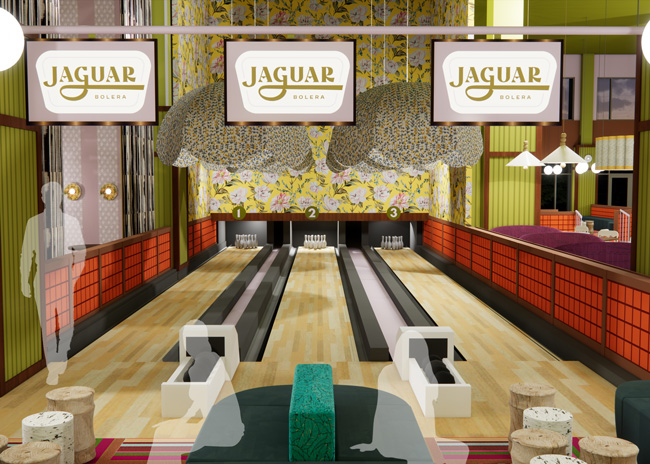 The “eatertainment” trend of combining recreational activities with a restaurant concept requires large spaces like the one for Camp Pickle. Image courtesy FAM Design
The “eatertainment” trend of combining recreational activities with a restaurant concept requires large spaces like the one for Camp Pickle. Image courtesy FAM Design
Siting and Demographics
For most restaurants, second-generation sites present advantages. “They already have grease traps and other utilities in place,” McGee observes. Brands don’t have to spend the money to install such essentials if the previous owner took care of those details.
Also attractive are first-generation spaces that have a concrete slab along the outer edges of the indoor space but not within the interior, Hlewicki says. These unfinished sites, with only gravel on the floor, are easier and less expensive to fit out with utilities than spaces with concrete already poured throughout. “If there is already a concrete floor, you have to cut the concrete and chip it out,” Hlewicki says. With an unfinished subfloor, designers can place drains and under-floor utilities exactly where they want without having to do any demo on the floor.
In addition to the characteristics of the site itself, brands analyze the demographics of the population in the immediate area. For higher-end establishments such as Shucking Good Hospitality’s venues, high-income areas are desirable. “These restaurants want areas where people eating out on a Tuesday with a $80 to $100 check is not as big a deal,” Mataipule says.
Many brands analyze extensive demographic data around potential expansion sites. Cici’s has their own analytic process, and the brand also engages with a real estate consultant that has a proprietary analytics service. The in-house and consultant’s data analysis tools yield critical insights that help determine whether a given site is a good fit. “We are a mid-range concept,” McGee says. “We are not looking at high-income areas.” An abundance of families with young children in the area is a good indicator of a location likely to support a successful new CiCi’s site. The presence of discount retailers such as WalMart and Dollar General nearby signal that the site can work for the brand, McGee says.
It’s important to visit the area in person, McGee says. “Don’t just rely on data,” she advises. “Spend time driving around and get a feel for the community.” When CiCi’s investigates a location, its representatives speak with businesses that have regular, meaningful interactions with residents. Car dealerships, for example, can offer instructive insight into the makeup of a community and the state of its local economy.
Some sites might appear attractive by data analysis, but site visits sometimes find problems. For instance, an older retail development might be struggling to keep up with competition from a newer shopping center in another area of town. This will become clear when a representative on a site visit discovers large swaths of empty parking or vacant store fronts. CiCi’s stays away from underperforming retail plazas.
The brand also takes care not to locate expansion sites too close to existing franchise locations. “We don’t want to risk cannibalization,” McGee says. On occasion, a site visit turns up a situation where the prospective site is in an area where the road configuration funnels a lot of traffic to other areas. Sometimes, an existing CiCi’s outlet is already present in one of those areas. Although the prospective site might otherwise seem far enough from the existing site, the traffic patterns would make it untenable for expansion due to the fear of stealing business from the existing franchisee.
 When prospecting for a new site, space for outdoor dining is a must for many concepts in post-pandemic times. Image courtesy of Jim Fink
When prospecting for a new site, space for outdoor dining is a must for many concepts in post-pandemic times. Image courtesy of Jim Fink
Proper Placement
A notable trend influencing site selection is developers’ and community planners’ goals of “proper placement” of new businesses and residential developments, Hlewicki says. The idea is to create a complementary blend of retail, food and beverage, apartments and condominiums, and services such as healthcare and education to support a thriving neighborhood. To attract the right mix of amenities, developers are reaching out to successful restaurateurs in the area to see if they would move or expand to their site.
More cities and towns are also being proactive about recruiting businesses including restaurants to areas of their community such as downtowns undergoing a revival. Chambers of commerce and quasi-public economic development agencies are often involved with these efforts. “You are going to see more of these grassroots efforts in cities across the country,” Hlewicki says. “These might include design charettes with a community engagement piece.”
Efforts to revitalize urban areas present opportunities to locate new restaurants in downtowns, but much of the action currently is happening in the suburbs. Finding the right location for your venture requires diligent research to find a place with appropriate site attributes and the desired demographics of the nearby population — whether in the city core or on the outskirts.

